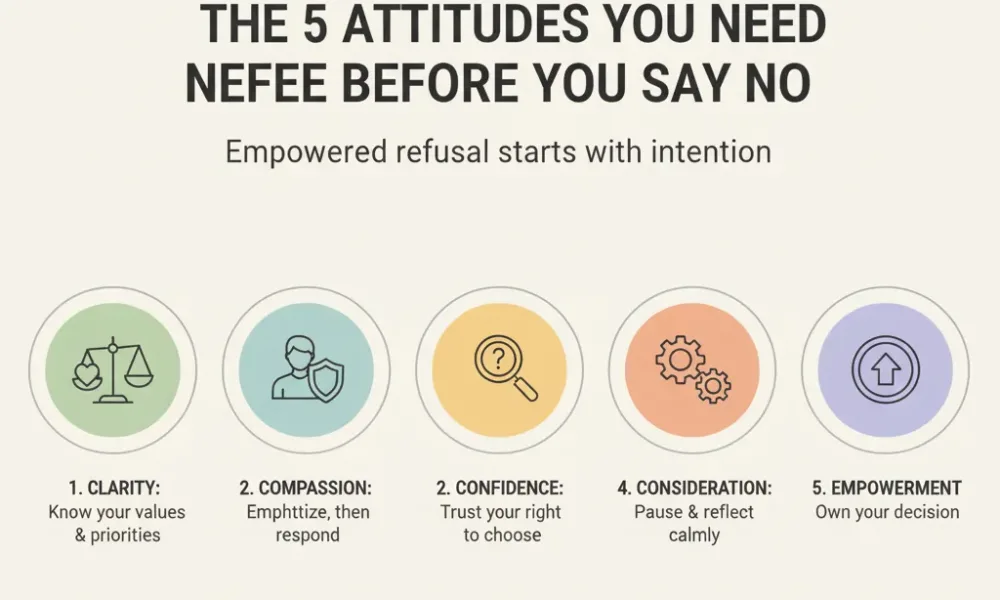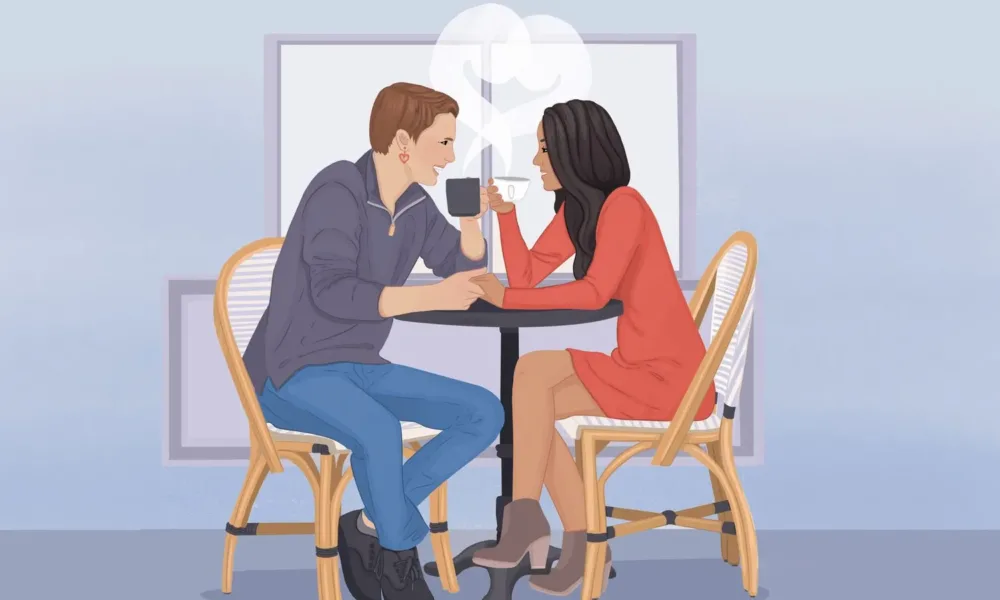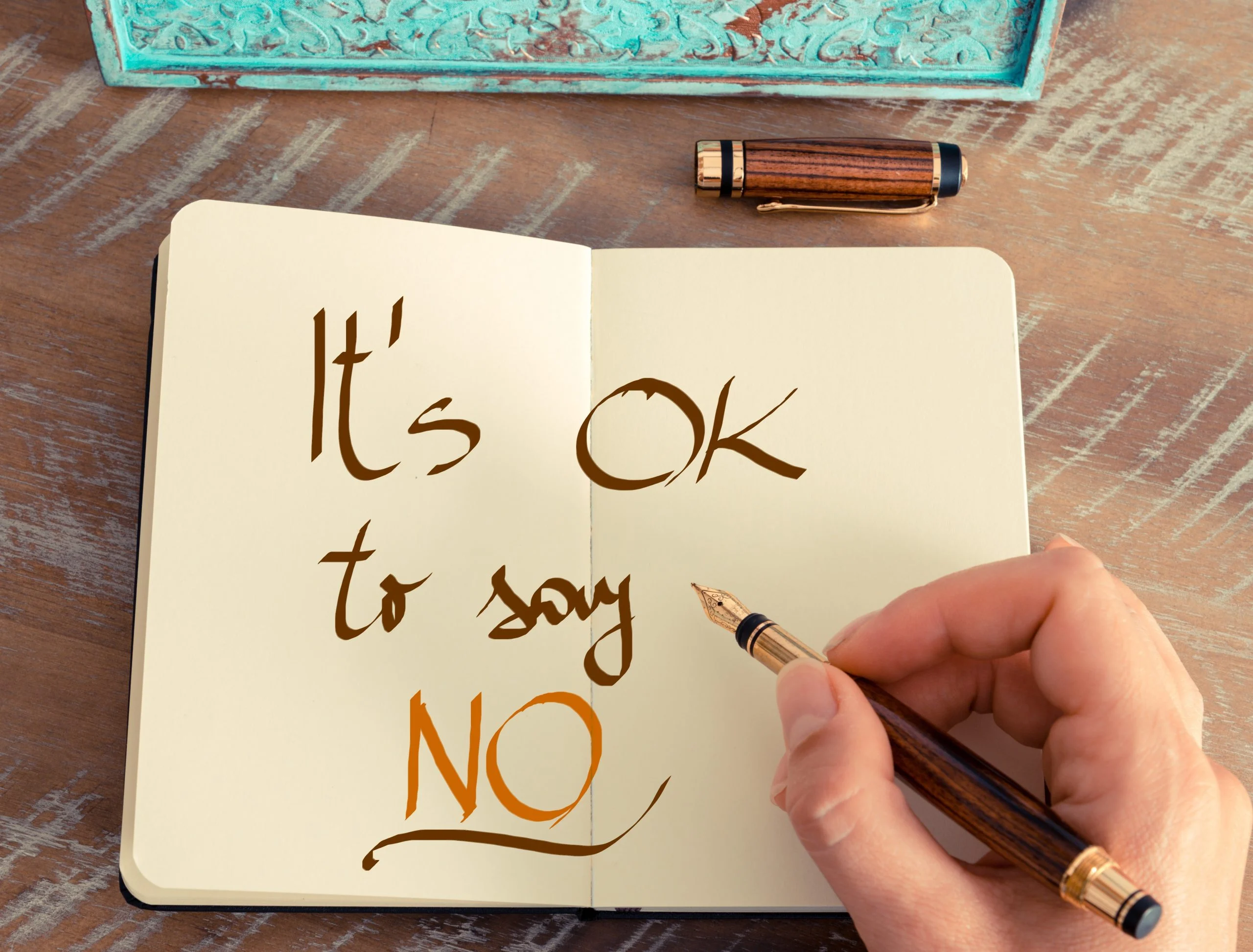Saying “no” is one of the most powerful skills you can learn. Yet many of us fumble, soften, or avoid it altogether. We end up overcommitted, resentful, and exhausted — wondering why other people get to choose while we say yes to everything. The truth: saying no is not rude. It’s honest. It keeps your life aligned with your priorities and protects the things that matter most.
This deep-dive teaches you how to say no with confidence and set clear boundaries — at work, with friends and family, in romantic relationships, and online — with scripts, body language tips, ways to handle pushback, and a 30-day practice plan so the next “no” feels natural.
Table of contents
- Why Saying No Matters (and why it’s hard)
- The 5 attitudes you need before you say no
- Types of boundaries to consider
- Simple scripts: exact words you can use (no fluff)
- How to say no at work (without sabotaging your career)
- How to say no to friends and family (with care)
- How to say no in a romantic relationship (intimacy & negotiation)
- How to say no online and in public spaces
- Body language & tone: nonverbal support for your no
- Handling pushback: scripts for when people don’t accept no
- Reclaiming your time later: follow-through & consequences
- How to handle guilt and internal resistance
- The practice plan: 30 days to owning your no
- FAQs
- Final checklist: confident no in six steps
- Closing: Saying no is self-care and truth-telling
Why Saying No Matters (and why it’s hard)
Why it matters
- Protects time and focus. Your attention is finite. Saying no preserves the space you need for what matters.
- Reduces resentment. Boundaries keep you from doing things you’ll later regret.
- Strengthens relationships. Paradoxically, honesty builds trust; people respect clear limits.
- Preserves energy & health. Chronic over-commitment leads to burnout, poor sleep, and stress.

Why it’s hard
- Fear of conflict or rejection — we worry “no” will offend.
- Guilt & people-pleasing — we equate being helpful with our self-worth.
- Unclear priorities — if you don’t know what matters, every request looks equally important.
- Social norms & culture — some environments reward constant availability.
Understanding the “why” helps you practice compassion toward yourself while getting practical.
The 5 attitudes you need before you say no
Confidence in saying no isn’t just technique — it starts inside you. Develop these attitudes:
- You are allowed to choose. Your time and needs matter.
- Boundaries are kind. They protect everyone — including the person asking.
- No is an answer, not an apology. It’s a sentence, not an essay.
- Clarity beats over-explaining. Short, honest responses are more respectful.
- Guilt is a feeling, not a fact. It may appear — but it’s not a reason to give in.

Adopting these mindsets reduces hesitation and softening language.
Types of boundaries to consider
Not all boundaries are the same. Choose which one you need for each situation.
- Time boundaries: e.g., “I don’t work after 6 PM.”
- Emotional boundaries: e.g., “I can’t listen to this topic tonight.”
- Physical boundaries: e.g., “I need personal space.”
- Digital boundaries: e.g., “No work texts on weekends.”
- Financial boundaries: e.g., “I don’t lend money.”
- Role boundaries: e.g., “I’m not your therapist.”
Labeling the boundary clarifies what you’re protecting and why.
Simple scripts: exact words you can use (no fluff)
Use these short, effective templates and adapt the tone to your personality.
Neutral, firm no (basic)
- “No, I can’t.”
- “I’m not able to take that on.”
- “I’m going to pass, thanks.”
No + brief reason (optional)
- “No — I’m booked that day.”
- “I can’t; I’m focusing on a deadline.”
- “I’m saying no because I need to prioritize family time.”
No + alternative (generous, keeps doors open)
- “I can’t help this month, but I can next month.”
- “I can’t attend, but I can join for the first 30 minutes.”
- “I can’t take that project, but I can recommend someone.”
No + boundary + consequence (clear)
- “I don’t do work calls after 6 PM. If it’s urgent, email and I’ll respond next business day.”
- “I won’t discuss this topic during dinner; if it comes up we’ll table it.”
The delay technique (buys time)
- “Let me check my calendar and get back to you.”
- “I’ll need to think about it — can I tell you tomorrow?”
Empathetic no (for sensitive relationships)
- “I appreciate you thinking of me, but I can’t right now.”
- “I wish I could help, but I don’t have the capacity. I hope you find someone who can.”
No for sales/pitch calls
- “I’m not interested — please remove me from your list.”
- “I don’t make purchases on calls. If you email details, I’ll consider it.”
Keep responses short. If pressed, repeat your answer calmly.
How to say no at work (without sabotaging your career)
Saying no at work is delicate because reputation and relationships matter. Use principles: clarity, offer options when possible, and stick to priorities.

Tactics
- Use the “Yes, and” for negotiation: “Yes, I can take this, and I’ll need to shift X or delay Y. Which do you prefer?”
- Use the “priority check” method: “What is the priority here compared to my current tasks? I can reassign time but something else will be delayed.”
- Set time boundaries: “I’m happy to handle this during my core hours (9–4).”
- Use delegation: “I can’t take this, but I recommend asking Sam — they handled a similar project.”
Script examples
- Manager asks for extra work: “I can help, but it will push back the Johnson deliverable by two days. Shall I proceed?”
- Colleague asks for a favor: “I’m booked this week. If you can wait until next week, I’ll help then. Or I can point you to a template that might speed things up.”
Document decisions so expectations are clear. Saying no at work becomes professional when framed around priorities and outcomes.
How to say no to friends and family (with care)
Personal relationships make saying no harder because you don’t want hurt feelings. Still, clear boundaries improve closeness long-term.
Tactics
- Use “I” statements: “I can’t” rather than “You always…”
- Be prompt — don’t delay saying no unnecessarily (that creates false hope).
- Offer short kindness if you want: “I can’t pick up, but I can drop off dinner.”
- Be honest about capacity, not morality. “I’m wiped out this week” is acceptable.

Scripts
- Friend invites you out: “Thanks for inviting me. I’m going to skip tonight — I need a quiet evening.”
- Family asks a favor: “I can’t hosts this time. I’d love to help in other ways — can I bring dessert instead?”
- Persistent parent push: “I hear how important this is. I can’t participate, and I need you to respect my choice.”
Practice holding your ground with warmth.
How to say no in a romantic relationship (intimacy & negotiation)
Boundaries here are essential because emotional stakes are high.
Tactics
- Be clear and compassionate. Use empathy but stay firm.
- Explain needs, not blame. “I need more alone time to recharge” vs “You’re too needy.”
- Negotiate, don’t capitulate. If connected, explore alternatives together.

Scripts
- Partner requests time together when you’re exhausted: “I value our time. Tonight I’m really depleted; can we plan something for Saturday?”
- Asked to meet the family when you’re not ready: “I’m not comfortable yet. Let’s talk about what would make that feel easier.”
Set consequences gently — “I’ll be exhausted and resentful if I don’t get downtime” — then follow through.
How to say no online and in public spaces
Digital requests are constant; public asks can be uncomfortable.
Online
- Use canned replies: Short, consistent responses reduce emotional labor.
- Mute & block when necessary. Your peace is not your duty to explain.
- Don’t engage trolls. No reply is a boundary.
In public
- Keep it short: “No, thank you.”
- Use body language: Turn slightly away, make eye contact briefly, carry yourself away.
- If pressed: “I said no” and continue walking.
You don’t owe strangers a rational explanation.
Body language & tone: nonverbal support for your no
What you say is amplified by how you say it.
- Stand tall. Good posture conveys certainty.
- Use a calm, steady voice. Avoid high pitch or rushing.
- Maintain soft eye contact. Not aggressive, but present.
- Breathe. Slow exhalation before speaking steadies you.
- Use minimal gestures. Keep hands relaxed; unnecessary movement weakens your words.
Practice in a mirror or on a short video to see how you come across.
Handling pushback: scripts for when people don’t accept no
When someone tries to override your no, stay calm and repeat.
Common pushbacks & replies
- “Are you sure?” → “Yes, I’m sure.”
- “It’ll just take five minutes.” → “I can’t right now.”
- “You always say no.” → “I say yes to some things and no to others — right now this doesn’t work.”
- “Fine, be that way.” (guilt trip) → “I’m sorry you feel that way. I’m making the choice that works for me.”
- Persistent asking → Use the broken record: repeat your no without new justification.
If pressure escalates into disrespect, end the interaction or leave.
Reclaiming your time later: follow-through & consequences
Setting a boundary may require follow-through when others test it.
- State consequences ahead of time: “If you call me after 8 PM for work, I won’t answer.”
- Enforce kindly: Don’t pick up — consistency teaches others what you mean.
- Adjust as needed: Boundaries can be renegotiated when life changes.
Consistency is the language that makes boundaries stick.
How to handle guilt and internal resistance
Guilt is a common reaction. Use these steps:
- Name it: “I notice guilt rising.”
- Check facts: Are you harming anyone? No = guilt is a feeling, not proof.
- Reframe: Saying no is saying yes to priorities.
- Small exposure: Practice small nos to build comfort.
- Self-compassion: Remind yourself decisions are choices, not moral failings.
Therapy or coaching can help people-pleasers rewire the habit loop.
The practice plan: 30 days to owning your no
A short, daily practice builds muscle memory.
Week 1 — Notice & Prepare
- Day 1–3: List your top 5 priorities.
- Day 4–7: Identify 3 no’s you avoided and how you’ll say them differently.
Week 2 — Practice small nos
- Practice saying no to small requests (texts, casual favors). Use the neutral scripts. Note how you feel.
Week 3 — Rise to medium nos
- Say no to a time-suck commitment (event, extra work). Use delay + clear reason + alternative.
Week 4 — Maintain & reflect
- Enforce one boundary (no email after 7 PM). Track outcomes. Reflect weekly in a short journal: what changed? What resistance appeared?
Small wins lead to bigger confidence.
FAQs
Q: What if saying no risks my job?
A: Frame around priorities and alternatives. Document requests and conversations. If the culture requires constant availability, evaluate whether the role fits long-term.
Q: What if the person becomes angry?
A: Stay calm and avoid escalation. You can exit the situation. Anger is a reflection of their reaction, not your wrongdoing.
Q: How do I say no to network opportunities?
A: Be brief and considerate — “Thanks, I’m focused on other projects. I wish you luck.” Offer to connect later if genuine.
Q: Can I change my mind after saying no?
A: Yes. You can revise boundaries. If you change, communicate clearly: “I rethought it and I can help. I’ll need X.”
Final checklist: confident no in six steps
- Pause & breathe. One deep breath before you answer.
- State your no clearly and briefly. (“No, I can’t.”)
- Optional reason (short) or boundary label.
- Offer an alternative only if you genuinely can.
- Use body language (stand tall, steady voice).
- Repeat & enforce if pressed. Stay consistent.
Closing: Saying no is self-care and truth-telling
Saying no may feel awkward at first, but each clear, kind refusal builds a life aligned with what matters. Boundaries are not barricades; they’re gates that let what you truly want flow in. Practice compassion for yourself as you build this muscle. The world will keep asking. You’ll keep choosing.
Start today: pick one small request you’ll refuse and use one of the scripts above. Notice the relief. That’s the sound of space being created — for what matters most.
Strengthen Your Boundaries with Clarity and Confidence
If this article helped you embrace the power of saying “no,” here are a few more reads to help you build stronger boundaries, protect your energy, and communicate with confidence:
- The Science of Self-Love: How to Cultivate It in Your Daily Life – Learn how building self-love naturally strengthens your ability to set healthy boundaries.
- How to Deal with Negativity: Strategies for Every Situation – Discover tools to handle negative people and situations without compromising your peace.
- Overcoming Self-Doubt: Strategies to Build Unshakable Self-Confidence – Boost your confidence so saying “no” feels natural, not guilt-filled.
Need a Confidence Boost Before Setting Boundaries?
Self-Respect Quotes – A powerful collection of quotes to remind you of your worth, your voice, and your right to say no.
